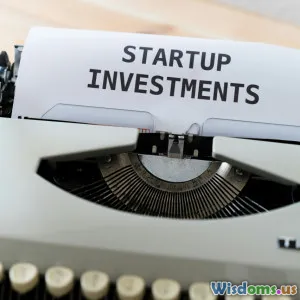
Innovation Management Trends That Will Shape 2025
9 min read Explore transformative innovation management trends defining 2025 with real insights driving organizational success and competitive advantage. (0 Reviews)
Innovation Management Trends That Will Shape 2025
Innovation management is no longer a luxury reserved for a select few companies; it has become essential for survival in today’s high-speed, highly competitive environment. As we edge closer to 2025, the way organizations approach innovation is undergoing a profound transformation driven by technological progress, evolving customer expectations, and global socio-economic shifts. In this article, we explore the most pivotal innovation management trends expected to shape the coming year, bringing fresh perspectives backed by data, examples, and expert opinions to help business leaders, managers, and innovators stay ahead of the curve.
1. Introduction: The Innovation Imperative
Traditional innovation models—characterized by siloed R&D departments and linear project pipelines—are fading into obsolescence. The accelerating pace of digital disruption, alongside heightened global challenges such as climate change and resource scarcity, requires more dynamic, agile, and collaborative approaches to managing innovation. According to a 2023 PwC report, 61% of CEOs view innovation as central to growth, yet only 15% claim they have a mature innovation process.
Consequently, innovation management is evolving into a strategic function that blends technology, culture, and stakeholder engagement. The trends emerging today will not only dictate the development of cutting-edge products and services but will also redefine organizational culture and sustainability ambitions.
2. AI-Driven Innovation Becomes the Norm
Harnessing Artificial Intelligence Throughout the Innovation Lifecycle
Artificial Intelligence (AI) has shifted from a buzzword to a foundational pillar in innovation management. AI tools facilitate ideation, automate mundane tasks, and analyze vast datasets to uncover unseen opportunities.
For instance, IBM's Watson uses AI algorithms to predict emerging market trends and recommend strategic innovation priorities. Startups like Spate analyze billions of consumer interactions online, enabling companies to tailor product development based on nuanced consumer signals.
Declining costs of AI adoption have democratized access, enabling even medium-sized enterprises to embed AI-powered analytics, ideation platforms, and prototype testing. Gartner forecasts that by 2025, 75% of large enterprises will have adopted AI in at least one innovation-related process.
Enhancing Decision-making and Speed
AI-powered simulations shorten R&D cycles by enabling virtual prototyping and scenario testing. Siemens, for example, reduced design errors in industrial components by 30% through AI-driven simulation environments, accelerating time-to-market.
Moreover, AI enables real-time innovation performance tracking at a granular level, granting managers actionable insights to reallocate resources swiftly and pivot strategies. This agility enhances competitive advantage in uncertain markets.
3. Sustainability Embedded Within Innovation Strategy
From Compliance to Core Strategy
Environmental, Social, and Governance (ESG) factors are no longer peripheral concerns. They now drive innovation agendas across industries. According to McKinsey, 70% of companies view sustainability as a source of competitive advantage rather than just risk mitigation.
Tesla’s innovation management, for example, prioritizes sustainability at every step—from battery technologies to supply chain transparency. This holistic approach has helped Tesla become a dominant player in electric vehicles while inspiring traditional automakers toward greener strategies.
Circular Economy and Innovation
The integration of circular economy principles—designing products for longevity, recyclability, and resource efficiency—is a decisive innovation trend. Brands like Patagonia innovate with recycled materials and lifetime guarantees, setting benchmarks for sustainable product design that align with consumer values.
Innovation teams increasingly assess environmental impact alongside cost and feasibility, leveraging Life Cycle Assessments (LCAs) during the conceptual stages. Such systemic thinking positions sustainability as a business growth driver rather than a constraint.
4. Collaborative and Decentralized Innovation Ecosystems
Breaking Down Silos for Cross-Disciplinary Innovation
In 2025, successful innovation management transcends organizational boundaries. Collaborative platforms allow companies to tap into distributed expertise—from employees to customers, startups, academia, and even competitors.
Unilever’s Foundry platform exemplifies this trend by partnering with startups worldwide to accelerate co-created solutions. They have successfully launched innovations such as low-impact packaging by crowdsourcing ideas.
Similarly, Cisco employs an innovation hub approach, hosting multidisciplinary teams with diverse skills to tackle complex challenges collectively.
Blockchain and Tokenization for Innovation Incentives
Decentralized technologies also foster transparent and trust-enhanced collaboration. Blockchain can enable secure IP sharing and token-based rewards for contributors in open innovation ecosystems, which incentivizes active participation.
Startups like Braintrust illustrate token-based ecosystems that reward innovation contributors in a freelancing network, proof that decentralization is expanding beyond cryptocurrencies to innovation management.
5. Human-Centered and Inclusive Innovation
Diversity Driving Creative Breakthroughs
The pandemic and social justice movements have highlighted the importance of inclusivity. Diverse teams, in terms of gender, ethnicity, cognitive styles, and backgrounds, generate richer innovation outcomes. Research from Boston Consulting Group shows that diverse companies report 19% higher innovation revenues.
Microsoft’s inclusive design principles serve as a benchmark, ensuring accessibility and broad usability in product development, thus opening new market opportunities and complying with global accessibility standards.
Empathy-Driven Product Development
Innovation management is adopting customer empathy tools such as ethnographic research and immersive user testing powered by VR/AR. Airbnb uses VR simulations to experience how hosts and guests interact, uncovering pain points that traditional surveys overlook.
These methods inform design decisions that increase customer satisfaction and loyalty, underscoring that understanding human needs remains central to innovation success.
6. Agile Innovation Governance and Metrics
Dynamic Frameworks Over Rigid Structures
Rigid governance previously hampered innovation agility. The trend now moves toward modular innovation portfolios, rapid failing cycles, and adaptive KPI frameworks that balance creativity with accountability.
Spotify’s “fail-fast” culture exemplifies agile governance, encouraging teams to rapidly prototype, test, and refine ideas with real-time user feedback.
Beyond ROI: Measuring Innovation Impact Holistically
While financial returns remain critical, companies are expanding metrics to include social impact, sustainability gains, and ecosystem effects. Frameworks like the Impact-Effort Matrix and Innovation Accounting help leaders prioritize initiatives that align with long-term strategic value.
7. Conclusion: Preparing for the Innovation Future
As we approach 2025, innovation management stands at an inflection point. Organizations that integrate AI, embed sustainability, foster collaborative networks, and champion human-centric approaches will not only survive but thrive. The rapidly evolving landscape demands leaders rethink traditional innovation paradigms—balancing speed, inclusivity, sustainability, and technological leverage.
To conclude, innovation is no longer just about creating new products; it’s about crafting resilient, future-ready ecosystems responding dynamically to global challenges. Embracing these trends today paves the path for tomorrow’s transformative successes.
References
- PwC, CEO Survey 2023
- Gartner, Innovation Adoption Report 2024
- McKinsey & Company, Sustainability & Innovation Insights 2023
- Boston Consulting Group, Diversity and Innovation Analysis 2022
- Examples from Tesla, IBM Watson, Unilever Foundry, Airbnb VR, Siemens
Innovation management in 2025 promises to be more intelligent, collaborative, sustainable, and human-centered than ever before. The future awaits the bold innovators who dare to adapt and evolve.
Rate the Post
User Reviews
Other posts in Business Strategy
Popular Posts
















